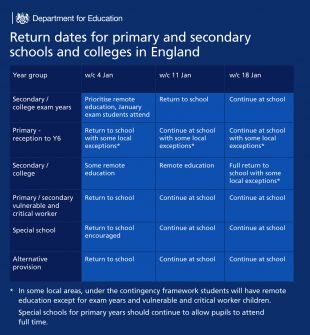
On 30 January, the Government responded to rapidly rising case rates due to the new, more transmissible variant of coronavirus by triggering the education contingency framework and pushing back the staggered return for secondary schools and colleges by one week.
What you need to know:
What have you announced?
During the first week of spring term, beginning on or just after 4 January, secondary schools and colleges will focus on the rollout of rapid testing to help find asymptomatic cases. The provision of testing builds on the extensive protective measures already in place in schools and colleges to make them as safe as possible.
Secondary schools and colleges, will continue with a staggered return but with one week’s delay, providing face-to-face education for exam year groups from 11 January and the return of all students by 18 January. Vocational exams scheduled for the first weeks of January will go ahead as planned. For alternative provision and special schools and colleges, pupils will return to face to face education from the start of term as planned with some flexibility for special schools and colleges on face to face attendance of pupils/students in the first week of term of enable them to appropriately mobilise the testing programme.
Early years, primary schools, alternative provision and special schools where primary aged pupils will return to face-to-face education from the start of term as planned.
This table sets out how the start of term will work.

So what is the contingency framework?
In response to this concerning data, and to supress the spread of the virus, protect public health and save lives, the contingency framework for education, first published in November, will be implemented in areas of the country with very high rates of incidence or transmission of the virus.
Where the contingency framework is implemented, schools and further education colleges should only allow vulnerable children, children of critical workers, and exam students to attend. High-quality remote education should be provided for all other pupils. This will be for the shortest time possible.
Evidence suggests that transmission is limited between young children, and the decision to close primary schools will be based on higher thresholds than for secondary schools and colleges. Early years will remain open nationally, as will alternative provision and special schools.
The contingency framework is being implemented at this time for primary schools in some areas requiring these schools to offer face-to-face education to vulnerable and critical worker children, and remote education to all other students. The framework is not being implemented due to safety concerns in education. Schools have well established protective measures in place to maximise safety for pupils and staff and help reduce the risk of transmission.
Which areas will be covered
Additional London boroughs added:
Camden, City of London, Greenwich, Hackney, Haringey, Harrow, Islington, Kingston upon Thames, Lambeth, Lewisham
Original London:
Barking and Dagenham, Barnet, Bexley, Brent, Bromley, Croydon, Ealing, Enfield, Hammersmith and Fulham, Havering, Hillingdon, Hounslow, Kensington and Chelsea, Merton, Newham, Redbridge, Richmond-Upon-Thames Southwark, Sutton, Tower Hamlets, Waltham Forest, Wandsworth, Westminster
Essex:
Brentwood, Epping Forest, Castle Point, Basildon, Rochford, Harlow, Chelmsford, Braintree, Maldon, Southend on Sea, Thurrock
Kent:
Dartford, Gravesham, Sevenoaks, Medway, Ashford, Maidstone, Tonbridge and Malling, Tunbridge Wells, Swale
East Sussex:
Hastings, Rother
Buckinghamshire:
Milton Keynes
Hertfordshire:
Watford, Broxbourne, Hertsmere, Three Rivers
How did you pick the areas?
We work closely with PHE, the NHS, with DHSC and across government to monitor the number of new infections, positivity rates, and pressures on the NHS. The contingency framework has been applied to address local areas with high rates of infection and with significant increases in 7-day case rates, and pressure on the NHS.
In light of Covid case rates rising rapidly across the capital and ongoing engagement with London leaders and the evidence submitted, the government has reviewed the London boroughs where the contingency framework will apply, with all further boroughs added.
What was the criteria for some schools reopening and some schools staying closed?
Gavin Williamson says the decision was led by public health data and made as a joint-decision with the Health Secretary.
He says he’s seen how much his own children miss from being out of school. pic.twitter.com/leI8xwj7By
— Good Morning Britain (@GMB) December 31, 2020
So how long will all this last?
The Secretary of State has been clear that this will last for the shortest amount of time possible – but we will be guided by infection rates, pressures on the NHS and more.
Who should be getting remote education and when?
In the first week of term schools and colleges with secondary aged pupils should prioritise providing remote education to exam year groups in line with what they would receive in class. Other groups may still receive remote education. From the second week of term schools should provide remote education to all other year groups not in attendance.
Read more about our drive to make sure young people can access education remotely where necessary by providing a million laptops for them to use here.